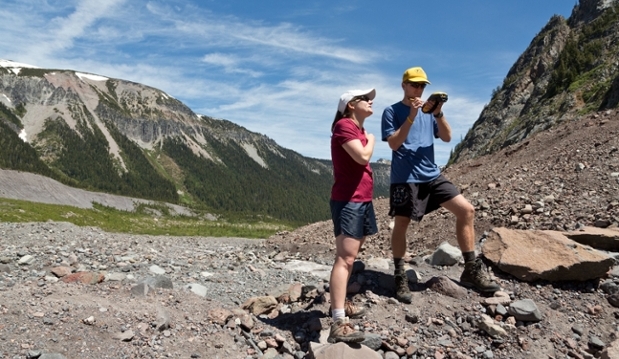Page 88 • (1,060 results in 0.058 seconds)
-
samples need to spin inside the magnet at nearly the speed of sound to get the best data. The spectrometer contains a series of chambers, with the outside chamber forming a vacuum jacket. The outer chamber is then filled with liquid nitrogen, which is at a temperature of minus 321 degrees Fahrenheit. Inside the chamber, a superconducting magnet sits in a broth of liquid helium, which is even colder, at minus 452 degrees Fahrenheit, or just a few degrees above the lowest known temperature in the
-

the group a bit about field craft, such as map reading and rope work. Swanson said that this year’s summer research really gave him a look into the scientific process and at “least a brief look at what scientists do in the field.” Todd said this is key, since each student on her team developed their own research study on the Rainier Mount Rainier and had to deal with some data that was expected, as well as some result that were unexpected. “It will help them deal with complexity and unknowns, and
-

call her in my head. She helps me take so many risks that I never thought I could accomplish. Her door is always open for me. Tell me about your favorite class at PLU. My favorite class was statistical consulting with Dr. [N.] Justice. We learned practical skills that will help in work as a data analyst or consultant. How has working with Campus Life as an ambassador for assessment, evaluation and research enriched your learning at PLU? I am taking it as practice for what I want to go into, which
-

answer to,” she said. “This gives them a first-hand look at how to ask the question, how to rule things out, how to set controls and interpret the new data.” Deane is one of approximately 30 students paired with about a dozen professors from the Division of Natural Sciences under PLU’s Summer Undergraduate Research Program. Each year the program gives up and coming scientists, such as Deane, a chance to do field or lab research, and gain hands-on experience that is rare for an undergraduate. Science
-

, McFadden ‘11 landed a position as a postdoctoral associate at the Yale Institute of Global Health in New Haven, Connecticut, where she spends her time analyzing factors that have caused child vaccination rates to decline in many parts of the country.Not that poring over such data was always her forte. Her passion was kindled years ago as a psychology undergrad at PLU — even if she had to overcome her initial dread of statistics and methods first. “I was terrified to take that class because I never
-
women, which would develop to become an interest in understanding oppression and how to act out against that in constructive ways. My capstone works at addressing the understanding of same-sex marriage in the overarching narrative of American marriages and redefinition of family life as a result of changes to the social and legal structures pertaining to marriage. Not just marriage equality for same-sex couples, but also legalization of interracial marriage, oral contraception, women’s presence in
-
coerced research. There remain open questions regarding Mengele’s research practices, how the twin and dwarf research was resourced in relation to SS administrative structures, and timing in relation to Mengele’s role as doctor to the Zigeunerlager and his role in genocidal selections on the ramp at Auschwitz. These issues shape the twins’ identities, numbers, retention of parents, and experiences between survival and death from experimental interventions. This paper develops evidence from the
-
teaches it to her class, and at the authorial level, Kamal wrote Unmarriageable as an adaptation of the original for her thesis. Although the characters are incredibly well-versed in Austen, they frustratingly never fully realize how their lives parallel Austen’s novel. For instance, Alys and her friend Sherry (Charlotte Lucas’s parallel) explicitly compare their lives to Pride and Prejudice in one scene and note only dissimilarities besides the social power structures that limit their choices (149
-
Protocol (IP) addresses, Internet domain and host names, browser software, and the date and time that the Site is visited. Data obtained through Google Analytics does not include, and is not linked, to any personal information. Data from Google Analytics allows us to monitor the use of the Site, understand how users find our Site, and improve the Site’s function and content. Site usage data collected through Google Analytics is not shared with other Google products and tools. Our use of Google
-
of the crystal. This research aimed to replicate the literature data and determine if the NMR peak broadening was a result of kinetics. This was done by lowering the temperature in the NMR while the sample ran, effectively slowing the kinetics and should have increased peak definition. Data collected thus far in time indicates that peak definition is independent of temperature and more dependent on ligand concentration. 2:30 pm - Binding Studies on Second Order Non-Linear Optical Chromophores and
Do you have any feedback for us? If so, feel free to use our Feedback Form.


